#comeheretome.com
Text
#OTD in 1907 – A memorial arch is dedicated at St Stephens Green Dublin in honour of the Irish soldiers who died fighting for “King and country” in the Boer war.
Five years on from the war, the Fusiliers’ Arch was unveiled in the heart of Dublin, as a testament to the actions of the Royal Dublin Fusiliers in South Africa. While the war ended in a British victory, it was a bloody and costly one. In financial terms, a war that would supposedly be over by Christmas 1899 by 1902 had cost the British taxpayer in excess of £200 million, while in excess of…
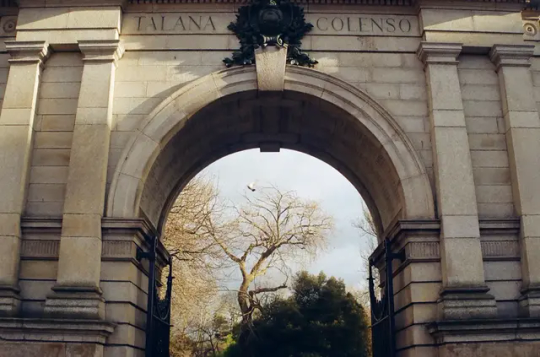
View On WordPress
#Boer War#Britain#Catholic#Colenso#comeheretome.com#Donal Fallon#Dublin#Freeman&039;s Journal#Fusiliers Arch#Ireland#John MacBride#Nationalist#Photography by Luke Fallon#Protestant#Royal Dublin Fusilliers#St Stephen’s Green#Stephen’s Green
9 notes
·
View notes
Text
Maynooth’s Demon, Denial, and the Horror of Rhetoric House
In the 1840s much of Ireland was looking to God and begging for answers. Political turmoil and religious conflict collided with the Great Irish Potato Famine bringing immense suffering to the Irish people who seemed to be losing everything and everyone around them. To many young men, the priesthood could promise many positive things during a time of crushing uncertainty like a connection to divinity, the opportunity to help heal the suffering all over the land, and the ability to serve in their spiritual beliefs. For some, it was a way to guarantee a roof over their head and a meal on their plates. Laying just outside of Dublin is Maynooth’s St. Patrick’s College, the training grounds for Ireland’s Roman Catholic priests since 1795. The school was operating less than a century when it was suddenly marked with unexplained horror.
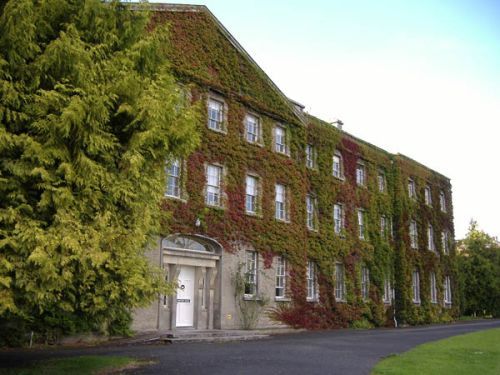
The outside of Rhetoric House at Maynooth (formerly known as Junior House). Image via comeheretome.com.
Not much is known about twenty-one year old Sean O’Grady before his arrival at Maynooth to study the priesthood. He was originally from Limerick and he was a fair student, attending to his studies and boarding in a small room in the residential hall called Junior House (later named Rhetoric House.) Within the first semester things began to change for the young student. The rules for priests-in-training were very strict and his mentors were not pleased to see that O’Grady was letting his studies slip, that he was not attending masses, and that he was increasingly absent for even the most basic requisites. One March morning in 1841 the Dean had had enough of the seemingly lazy student and he made his way up the stairs of Junior House, to Room No. 2, to confront O’Grady. When the door was opened the student was found slumped over on the floor. His sink was full of water, his hand grasped a razor, and the blood that poured from his slit throat was already soaked into the floorboards.
When Thomas McGinn took up residency in Room No. 2 many years later no one told him what history that room held or why it had been left vacant for so long before he was placed there. No one explained the stains on the floor, no one spoke the previous tenant’s name, and McGinn settled in for what he probably expected to be a year of hard study. It is unknown if the Dean or any of the faculty thought of the room’s previous occupant when McGinn began to complain of bad dreams, difficulty focusing, and a general feeling of doom enveloping him. If anyone thought of speaking to McGinn, they were too late. On an April morning in 1860 the quiet landscape of Maynooth was shattered when the student’s body crashed through the window and hit the ground so many floors below with a sickening thud. His bones were broken, he was holding a razor, and he was bleeding. But, he was alive.
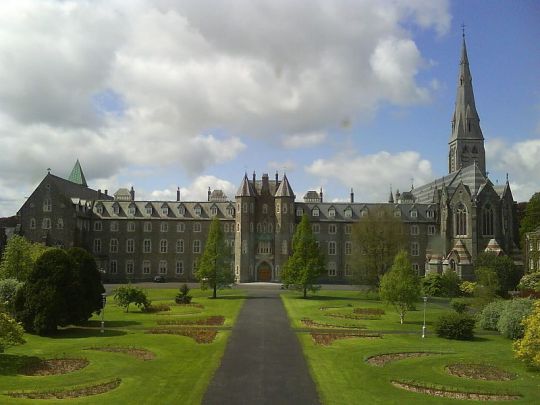
A view of St.Patrick’s College, Maynooth. Image via wikipedia.com.
When Vice President of the school Dr. McCarthy visited the shattered man in the infirmary, he received a shocking explanation of what happened. There was nothing accidental about the fall, he threw himself out the window and toward almost certain death. The reason was not suicide, it was fear. McGinn told the Vice President that as he was shaving that morning, razor in hand, he looked up and saw a demonic face behind him urging him to cut his own throat. According to the student he felt a force take his wrist and he knew the only thing to do was escape. But, the only way out was through the window to the ground below. McGinn died of his injuries on April 21st 1860.
The authorities at Maynooth had an urgent decision to make about Room No. 2 of Rhetoric House. The school and church leaders needed to keep the happenings as hidden as possible. The two students were buried in unmarked graves in the on-site cemetery. But were there only two? There are differing accounts with some people claiming there was actually another student, one that took up Room No. 2 in between O’Grady and McGinn who was also found in the room with their throat slashed. There are additional accounts of a priest spending a night in the room after the death of McGinn. He refused to believe all the whispering about the “cursed” room and he wanted to prove once and for all that this was nothing more than a set of tragic and unfortunate coincidences. According to the story, whatever he experienced made him bang on the walls and howl in agony the entire night but left him silent the next morning, refusing to speak of what happened to him in the room of Rhetoric House.
What is known for sure is that on October 23rd 1860 the Trustees decided to convert the room to an Oratory of St. Joseph. The decision was fast and according to the October 24th 1948 issue of Irish Independent, there was no reason given for the conversion. The window that McGinn used to escape evil was walled off, an alter was built, and a statue of St. Joseph was placed. St. Joseph is the patron saint of a peaceful death.

Piece about the Maynooth “Ghost Room” appearing in Irish Independent on October 24th 1948. Image via comeheretome.com.
Room No. 2 of Rhetoric House underwent many changes in the subsequent years, utilized as academic office spaces and a waiting area between offices. Throughout all its incarnations the stories remained and the small room in Rhetoric House began to attract some possibly unwanted attention. In 1998 renowned paranormal researcher, author, and parapsychologist Hans Holzer included the seminary in his book Hans Holzer’s Travel Guide to Haunted Houses and his account of visiting the infamous Room No. 2 with psychic medium Sybil Leek appeared in his book This House is Haunted.

An image of the room as it appeared in 1978 from the Irish Independent June 25th 1978. Image via comeheretome.com.
Today the stories of “The Blood Room” of Maynooth are still spoken, helping the college to earn the dubious distinction of one of the most haunted locations in Ireland. The locations tied to the stories are all still there and out in the open. The stones in the cemetery placed for Sean O’Grady and Thomas McGinn stand without their names and the window where McGinn fell can still be seen from the outside of the building, easily identified as the window that has a blank wall behind its glass. A large bronze plaque names all the deceased buried at Maynooth and among them can be found the names Sean O’Grady and Thomas McGinn. The main goal for visitors though, is to set foot inside Room No. 2 itself. Mostly empty today, the room stand silent with the alter and St. Joseph still watching over the space. Take note though, visitors to the room are forbidden to bring mirrors inside.
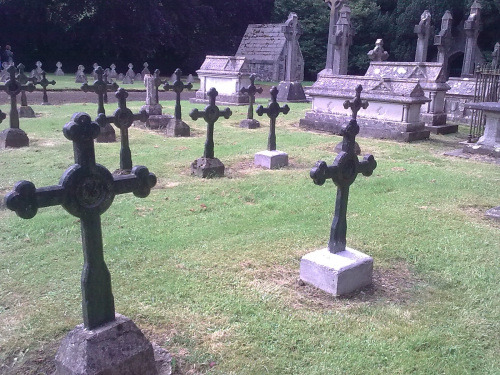
The crosses with no names thought to be the final resting places of Sean O’Grady and Thomas McGinn. Image via comeheretome.com.
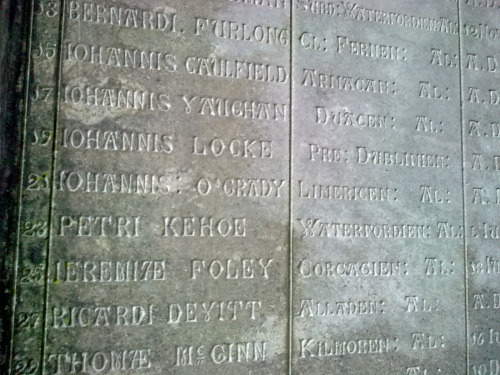
The names of the deceased of Maynooth. Image via comeheretome.com.
On the floor is a large, old, dark stain. Allegedly tested by the school’s Chemistry department and proven to be human blood, the stain is sunken deep into the wooden floorboards, refusing to move after every attempt at removal over the last 160 years.
********************
Sources:
https://comeheretome.com/2012/07/20/the-ghost-room-in-maynooth/
https://soundcloud.com/ghost-maynooth/maynooths-ghost-room
https://www.cultofweird.com/paranormal/maynooth-ghost-room/
#HushedUpHistory#featuredarticles#Ireland#IrishHistory#paranormal#paranormalhistory#Maynooth#unexplained#historicbuildings#historicschool#scarystory#scaryhistory#creepyhistory#forgottnehistory#weirdhistory#horrorhistory#historyisnotboring#demonichistory#unsolved#mystery#coverup#creepy#whathappenedhere#haunted#HauntedIreland#Irishhaunting#terrifyingstory#stillthere#history#historyclass
7 notes
·
View notes
Text
Royal Irish Regiment History
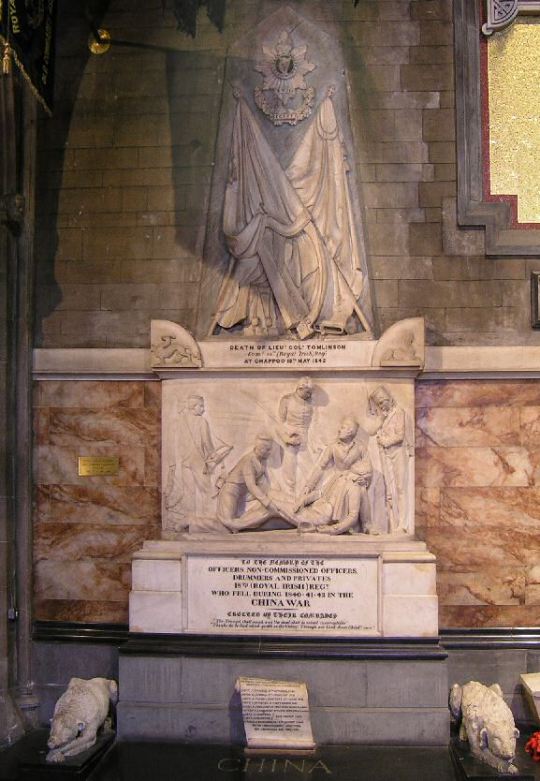
The memorial in St. Patrick’s Cathedral in Dublin to the men of the Royal Irish Regiment who died in the First China War 1839 - 1842. Only the names of the officers are recorded on the scroll at the bottom. Of the 248 men who died in the war, only a dozen were killed in action or died of wounds.The rest succumbed to diseases like Malaria, Cholera and Dysentry.
Photo Credit; https://comeheretome.com/2010/08/07/dublins-war-memorials/
3 notes
·
View notes
Link
0 notes
Link
If I hadn’t have been -3 years old at the time I would have moved in
#stop making sense#sms#dublin#ireland#talking heads#th#db#david byrne#my friend used to always go to it though#I saw it in the cinema for the first time with her
0 notes
Link
Ronald McDonald, the ITGWU and Soviet Russia.
0 notes
Link
1940-03-23 – John McCarthy (37) of Castletownbere , County Cork – died in IRL. Fought for Franco.
0 notes
Text
Bye Bye Badman: King Baudouin in TCD | Come Here To Me!
https://comeheretome.com/2018/03/20/bye-bye-badman-king-baudouin-in-tcd/
View On WordPress
0 notes
Text
Sad news that the Sackville Lounge is to close. Must try and get in to taste their Toastie before it’s gone... https://comeheretome.com/2017/01/27/farewell-to-the-sackville/
0 notes
Text
#OTD in 1907 – A memorial arch is dedicated at St Stephens Green Dublin in honour of the Irish soldiers who died fighting for “King and country” in the Boer war.
#OTD in 1907 – A memorial arch is dedicated at St Stephens Green Dublin in honour of the Irish soldiers who died fighting for “King and country” in the Boer war.
Five years on from the war, the Fusiliers’ Arch was unveiled in the heart of Dublin, as a testament to the actions of the Royal Dublin Fusiliers in South Africa. While the war ended in a British victory, it was a bloody and costly one. In financial terms, a war that would supposedly be over by Christmas 1899 by 1902 had cost the British taxpayer in excess of £200 million, while in excess of…
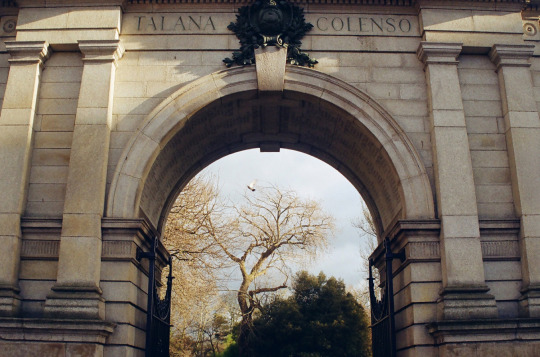
View On WordPress
#Boer War#Britain#Catholic#Colenso#comeheretome.com#Donal Fallon#Dublin#Freeman&039;s Journal#Fusiliers Arch#Ireland#John MacBride#Nationalist#Photography by Luke Fallon#Protestant#Royal Dublin Fusilliers#St Stephen’s Green#Stephen’s Green
3 notes
·
View notes
Text
#OTD in 1907 – A memorial arch is dedicated at St Stephens Green Dublin in honour of the Irish soldiers who died fighting for “King and country” in the Boer war.
#OTD in 1907 – A memorial arch is dedicated at St Stephens Green Dublin in honour of the Irish soldiers who died fighting for “King and country” in the Boer war.
Five years on from the war, the Fusiliers’ Arch was unveiled in the heart of Dublin, as a testament to the actions of the Royal Dublin Fusiliers in South Africa. While the war ended in a British victory, it was a bloody and costly one. In financial terms, a war that would supposedly be over by Christmas 1899 by 1902 had cost the British taxpayer in excess of £200 million, while in excess of…

View On WordPress
#Boer War#Britain#Catholic#Colenso#comeheretome.com#Donal Fallon#Dublin#Freeman&039;s Journal#Fusiliers Arch#Ireland#John MacBride#Nationalist#Photography by Luke Fallon#Protestant#Royal Dublin Fusilliers#St Stephen’s Green#Stephen’s Green
4 notes
·
View notes
Text
#OTD in 1907 – A memorial arch is dedicated at St Stephens Green Dublin in honour of the Irish soldiers who died fighting for “King and country” in the Boer war.
#OTD in 1907 – A memorial arch is dedicated at St Stephens Green Dublin in honour of the Irish soldiers who died fighting for “King and country” in the Boer war.
Five years on from the war, the Fusiliers’ Arch was unveiled in the heart of Dublin, as a testament to the actions of the Royal Dublin Fusiliers in South Africa. While the war ended in a British victory, it was a bloody and costly one. In financial terms, a war that would supposedly be over by Christmas 1899 by 1902 had cost the British taxpayer in excess of £200 million, while in excess of…
View On WordPress
#Boer War#Britain#Catholic#Colenso#comeheretome.com#Donal Fallon#Dublin#Freeman&039;s Journal#Fusiliers Arch#Ireland#John MacBride#Nationalist#Photography by Luke Fallon#Protestant#Royal Dublin Fusilliers#St Stephen’s Green#Stephen’s Green
2 notes
·
View notes
Text
#OTD in 1907 – A memorial arch is dedicated at St Stephens Green Dublin in honour of the Irish soldiers who died fighting for “King and country” in the Boer war.
#OTD in 1907 – A memorial arch is dedicated at St Stephens Green Dublin in honour of the Irish soldiers who died fighting for “King and country” in the Boer war.
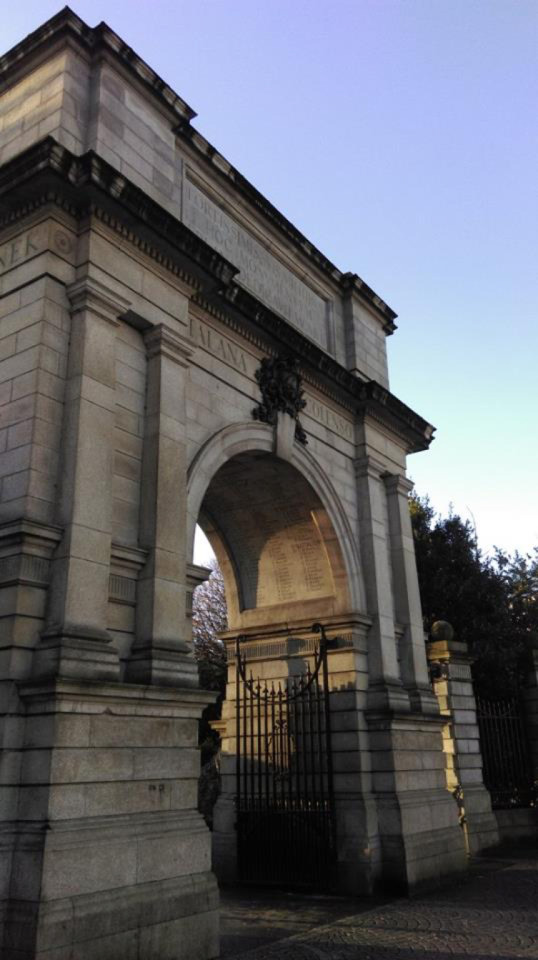
Five years on from the war, the Fusiliers’ Arch was unveiled in the heart of Dublin, as a testament to the actions of the Royal Dublin Fusiliers in South Africa. While the war ended in a British victory, it was a bloody and costly one. In financial terms, a war that would supposedly be over by Christmas 1899 by 1902 had cost the British taxpayer in excess of £200 million, while in excess of…
View On WordPress
#Boer War#Britain#Catholic#Colenso#comeheretome.com#Donal Fallon#Dublin#Freeman&039;s Journal#Fusiliers Arch#Ireland#John MacBride#Nationalist#Photography by Luke Fallon#Protestant#Royal Dublin Fusilliers#St Stephen’s Green#Stephen’s Green
5 notes
·
View notes
Text
#OTD in 1907 – A memorial arch is dedicated at St Stephens Green Dublin in honour of the Irish soldiers who died fighting for “King and country” in the Boer war.
#OTD in 1907 – A memorial arch is dedicated at St Stephens Green Dublin in honour of the Irish soldiers who died fighting for “King and country” in the Boer war.
Five years on from the war, the Fusiliers’ Arch was unveiled in the heart of Dublin, as a testament to the actions of the Royal Dublin Fusiliers in South Africa. While the war ended in a British victory, it was a bloody and costly one. In financial terms, a war that would supposedly be over by Christmas 1899 by 1902 had cost the British taxpayer in excess of £200 million, while in excess of…
View On WordPress
#Boer War#Britain#Catholic#Colenso#comeheretome.com#Donal Fallon#Dublin#Freeman&039;s Journal#Fusiliers Arch#Ireland#John MacBride#Nationalist#Photography by Luke Fallon#Protestant#Royal Dublin Fusilliers#St Stephen’s Green#Stephen’s Green
2 notes
·
View notes
Text
#OTD in 1907 – A memorial arch is dedicated at St Stephens Green Dublin in honour of the Irish soldiers who died fighting for “King and country” in the Boer war.
#OTD in 1907 – A memorial arch is dedicated at St Stephens Green Dublin in honour of the Irish soldiers who died fighting for “King and country” in the Boer war.
Five years on from the war, the Fusiliers’ Arch was unveiled in the heart of Dublin, as a testament to the actions of the Royal Dublin Fusiliers in South Africa. While the war ended in a British victory, it was a bloody and costly one. In financial terms, a war that would supposedly be over by Christmas 1899 by 1902 had cost the British taxpayer in excess of £200 million, while in excess of…
View On WordPress
#Boer War#Britain#Catholic#Colenso#comeheretome.com#Donal Fallon#Dublin#Freeman&039;s Journal#Fusiliers Arch#Ireland#John MacBride#Nationalist#Photography by Luke Fallon#Protestant#Royal Dublin Fusilliers#St Stephen’s Green#Stephen’s Green
1 note
·
View note
Link
0 notes